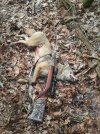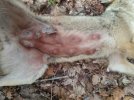I'm guessing, this nursing female was dropped at daybreak responding to a chicken distress which she knows well, seeing as she killed several of mine in the last week or so. I'm not bothered as they were 16 months and I planned on replacing them this week with fresh layers. Bovan Browns best egg layer on the planet.
-
If you are being asked to change your password, and unsure how to do it, follow these instructions. Click here
You are using an out of date browser. It may not display this or other websites correctly.
You should upgrade or use an alternative browser.
You should upgrade or use an alternative browser.
I killed at least two coyotes with one shot.
- Thread starter Ohlongarm
- Start date
 Help Support Long Range Hunting Forum
Help Support Long Range Hunting Forum
D
Deleted member 115360
Guest
That's an interesting milestone. I don't think the females have started leaving the dens yet down here in TN. I've only killed males for a couple of months now..
Coyotes and foxes have their liters here around April 15th I've kept records for years it seldom deviates.That's an interesting milestone. I don't think the females have started leaving the dens yet down here in TN. I've only killed males for a couple of months now..
Here they sometimes start in early April but I always figured on around April 25th . The females will spend the night with the younger pups but the male will come back and let her go out to feed and drink around 7 or 8 A.M. she will be back at the den around 12 or 1 P.M. . I have noticed that they will pull the fur off of their bellies and line the nest for the pups with it as well as making it easier for the pups to nurse when their eyes are still closed . She looks to close to weening her pups if you were to look at her uterus the purple lumps left from the pup attachments would probably be about the size of lima beans so they are probably nearly 7 or 8 weeks old at this time . Some people say you can tell how many pups she had by the number of nipples being used but I haven't found that to be true .
In my area the fox tend to have their kits about a month earlier then the coyote have their pups . I have taken fox kits as early as March 3rd here . It's interesting how the time frame for whelping changes from area to area isn't it .
D
Deleted member 115360
Guest
I think you guys misunderstood my statement. Our females have pups in the same time frame, but thr females won't get out of earshot of those pups for the first 6 or 8 weeks. I'm talking about seeing them out hunting. It's about that time, but I haven't called in a wet female in months.
Not really I figured that's about what you were saying I was just saying how ours in my area do things . The males here come back to the pups in the mornings around 7 or 8 A.M. here and pup set so that the females can go feed and drink water till the pups are about 3 to 4 weeks old then she will start to leave them by themselves and will ween them by about 7 or 8 weeks of age and be bringing soft food back to them in her stomach by around 3 or 4 weeks old and fairly solid foods starting around 6 weeks of age . Our breeding season is nearly the same as the ones back there sometimes running for a couple of months for coyote but it sounds like the breeding season for our fox may be starting a month or so earlier . I was just giving information as to the differences we have as compared to what you guys have back east just as an informational exchange .
You can Figure how many pups she had by counting her uterus scars. Almost dead on every time unless she lost one during birth. I would say you only killed one coyote there so far. Those pups are most likely alive in den somewhere. If they are old enough that they are either starting to be weened or are able to move around out of the den they could very easily survive. Coyotes have a great adoption program and take care of their own. If another coyote is around there is a good chance It will feed and take care of them. Like Dsheetz said look at the scares and see what Size they are. If they are getting hard to tell you will have pups still alive. If they are closer to the size of an acorn they may not make it. Out here we usually have a group of three coyotes. Old bitch and dog and a female pup kept back from the previous year. Had a group of three this week that two of them where old males. If any of them are still alive and pups are old enough they will be well taken care of. I have also seen pups survive on their own living off bugs or smaller amphibians and rodents. Looking at her belly those are older pups for sure.
D
Deleted member 115360
Guest
We've got the same problem in TN. I've got ranchers that want every one of them shot on sight, but it is illegal to kill them here. They have been seen attacking calves during birthing.Last year I was in southern Indiana for a couple of weeks about this time of the year and saw a ton of the black buzzards riding the air currents . My brother told me there are more of them now then he had ever seen in the past .
- Joined
- Nov 25, 2012
- Messages
- 314
Have your ranchers reach out to USDA Wildlife Services for assistance with the black vultures.We've got the same problem in TN. I've got ranchers that want every one of them shot on sight, but it is illegal to kill them here. They have been seen attacking calves during birthing.
Even though they are covered under a migratory bird treaty with Mexico, there are ways to address calf attacks and it doesn't cost the rancher a dime if Wildlife Services does the work.
For a long time the wildlife biologists denied that the black headed vultures were predatory, insisting that, like turkey vultures, they were scavengers.
In the Midwest, ranchers and Wildlife Services gathered enough evidence to show calf mortality and damage and there are now options to help with the problem.
There always has been, and still is, a process to follow if the rancher wants to do control himself, but they don't make it easy.
IMHO and experience, contacting USF&W (the folks who administer and enforce the treaty) about the problem is a waste of time.
Ed
What apddsn0864 said. They will maim/kill calves and other young livestock up here. Not a huge problem but I have had it happen a few times. Wildlife Services has a permit to take care of damages cause by vultures and some raptors.
Donneric
Well-Known Member
Where are you located?In my area the fox tend to have their kits about a month earlier then the coyote have their pups . I have taken fox kits as early as March 3rd here . It's interesting how the time frame for whelping changes from area to area isn't it .
Similar threads
- Replies
- 28
- Views
- 15K

